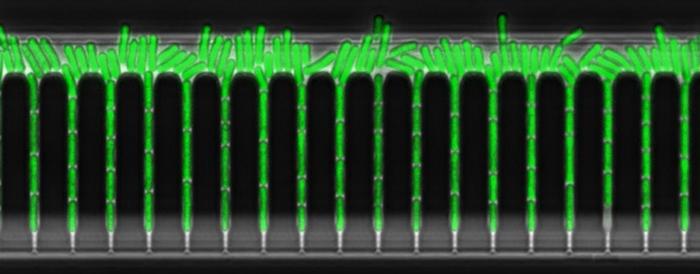In the ceaseless dance of day and night, biological clocks govern the rhythms of life, orchestrating processes essential for survival across the tree of life. Recent groundbreaking research has shed light on the intricate mechanisms that enable these clocks to maintain their precision amidst the cacophony of fluctuating environmental cues. A collaborative effort involving leading scientists from the Sainsbury Laboratory at the University of Cambridge, Imperial College London, the University of Warwick, and Forschungszentrum Jülich has unraveled how a simple circadian clock network can filter environmental “noise” to preserve robust timing in individual cells.
At the heart of this study lies the cyanobacterium Synechococcus elongatus, the simplest known organism endowed with a circadian clock. This unicellular photosynthetic bacterium serves as an elegant model to probe the dynamics of biological timing systems. The researchers harnessed advanced microfluidics technology, creating an innovative platform they dubbed the “Green Mother Machine,” which enables long-term imaging of single cells. This setup permitted the team to track gene expression oscillations and cellular growth with unprecedented temporal resolution under tightly controlled light environments.
The findings highlight the extraordinary ability of the cyanobacterial clock to maintain rhythmicity despite pervasive molecular noise. Intrinsic fluctuations in clock components and regulatory networks pose significant challenges to cellular timekeeping, yet Synechococcus elongatus demonstrates a remarkable resilience. Through genetic perturbations and mathematical modeling, the team revealed that the robustness is primarily derived from the core oscillator composed of three Kai proteins. These proteins undergo rhythmic cycles of phosphorylation and dephosphorylation, generating a stable ~24-hour rhythm even under continuous illumination.
Crucially, the study elucidates how the circadian system can differentiate between meaningful environmental signals and transient disturbances. Real-world environmental conditions are rarely stable—light intensity fluctuates due to clouds, and day length changes seasonally. By exposing the cyanobacteria to complex, realistically reproduced light-dark cycles modeled from Caribbean weather patterns, researchers observed that the clock architecture inherently filters out irrelevant noise while remaining sensitive to genuine changes. This selective responsiveness ensures that timekeeping retains both stability and adaptability.
The Green Mother Machine platform was essential for these insights, designed specifically to support photosynthetic microorganisms in microfluidic chambers with precise light control. Engineering this device required meticulous optimization to avoid impairing cyanobacterial physiology. Over several years, the team optimized materials and chip design to maintain intact photosynthetic membranes and cellular health, enabling extended single-cell monitoring with fluorescent reporters that track clock-related gene expression dynamics.
From a molecular viewpoint, the Kai proteins—KaiA, KaiB, and KaiC—form the core oscillator that underpins this extraordinary noise buffering. The phosphorylation state of KaiC cycles with a 24-hour period, modulated by interactions with KaiA and KaiB. By introducing mutations and measuring oscillation fidelity, the researchers demonstrated that natural selection has sculpted the clock to operate at a noise minimum, balancing stability with the ability to adjust. This intrinsic biochemical resilience ensures that the internal timekeeping does not drift erratically over days to months.
Such precision is critical not only for cyanobacteria but extends to more complex organisms, including humans, where circadian rhythms regulate sleep-wake cycles, metabolism, and cognitive performance. The gradual adaptation to new time zones known as jet lag exemplifies how internal clocks recalibrate with shifting environmental cues. Similarly, plants use circadian timing to optimize photosynthesis and growth, adjusting to varying photoperiods through the seasons without being misled by fleeting changes such as passing clouds.
The implications of this work resonate beyond basic biology. Understanding the principles by which simple biological clocks achieve noise filtering provides a blueprint for synthetic biology, where creating stable, tunable oscillators is a key challenge. Translating these biological motifs into engineered systems could lead to novel timekeeping devices in biotechnology and medicine. Furthermore, the mathematical models developed offer testable predictions for how clocks respond under naturalistic, fluctuating environments.
Importantly, the researchers emphasize that the scope of this robustness stems mostly from the core Kai protein oscillator rather than the broader gene regulatory network. This distinction redefines the focus for future interventions aimed at modulating circadian function. It underscores the power of biochemical oscillators in maintaining temporal homeostasis and reveals targets for synthetic modification or pharmacological manipulation.
Professor James Locke, who led the study at the Sainsbury Laboratory, remarked on the broader significance: “Our work demonstrates how a seemingly simple molecular network can be exquisitely tuned to operate reliably amid noise. This insight enriches our understanding of cellular timekeeping and offers a framework that could help explain how organisms from bacteria to humans synchronize with their environment.”
The collaborative nature of this study, bridging experimental microbiology, microfluidic engineering, and computational modeling, highlights the interdisciplinary approach necessary to decipher complex biological systems. It also sets the stage for future explorations into the molecular underpinnings of circadian resilience in diverse organisms and under varying environmental stresses.
This landmark research culminates in a paradigm shift regarding how circadian systems are viewed—not just as passive timekeepers but as active filters that sculpt temporal information. Their ability to distinguish signal from noise ensures robustness in the face of an inherently unpredictable natural world, allowing biological processes to operate with remarkable precision and stability.
Subject of Research: Cells
Article Title: Environmental and molecular noise buffering by the cyanobacterial clock in individual cells
References: Eremina, A., Schwall, C., Saez, T. et al. Environmental and molecular noise buffering by the cyanobacterial clock in individual cells. Nat Commun 16, 3566 (2025).
Image Credits: Credit: Sasha Eremina
Keywords
Cyanobacteria, Cellular noise, Molecular dynamics, Cell biology




